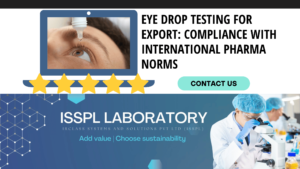An Overview by Team ISSPL - Analytical Testing Laboratory in India
ToggleDemineralised water is applied in industries where the presence of any minerals can lead to significant destruction. Whether it is power plants or pharmaceuticals, industries require water that is free of salts, metals and impurities. However, it is not sufficient to have demineralised water. You must demonstrate that it is up to standards and that involves testing.
Testing demineralised water is not a tick box. It is the way you ensure that your processes remain efficient, safe, and compliant. It does not matter whether you are working with boilers, cooling systems, lab instruments, or final product formulations, the quality of the water you use is what matters. This guide discusses the testing of demineralised water and achieving the standards that count.
Why Demineralised Water Needs Testing
Demineralised water is made by removing dissolved minerals—like calcium, magnesium, sodium, chloride, and sulfate—from raw water. The result is water that’s almost pure. But the catch is this: even trace levels of contaminants can cause corrosion, scaling, or product failure.
So, regular testing is necessary. Not just to monitor quality but to detect system issues before they become serious. Without testing, there’s no way to know if your demineralisation system is still working as intended.
Key Parameters You Have to Monitor
Industries are guided by strict rules. And the key parameters they are concerned with are:
- Conductivity: Must be between 0.08 to 2 0mS/cm based on application
- pH: It should be balanced, typically 6.0 to 8.0
- Silicates: As low as possible, usually < 20 ppb
- Heavy Metals: Copper, iron, zinc, and lead, similar to lead, should be non-detectable or far below the acceptable levels
- TOC: In particular, in sensitive applications such as pharma
When these figures fail to meet the standards, then the water cannot be utilized. And the results, machine damage, contamination, product rejection, can be costly.
Understanding Conductivity Standards
Conductivity is the first sign of water purity. It measures how well water conducts electricity, which depends on how many ions (charged particles) are in it. Demineralised water should have very low conductivity—ideally below 1 µS/cm.
Some applications need even stricter control. For example, ultrapure water systems might aim for ≤0.1 µS/cm. If your conductivity reading is creeping up, it means your resins or membranes might be failing. That’s why it’s often monitored continuously.
The Role of pH in Water Stability
Demineralised water can be aggressive. Once it’s stripped of minerals, it tries to rebalance by pulling ions from metal pipes. That can lead to corrosion. So, pH needs to be controlled.
In most industrial cases, pH should sit between 6 and 8. Too acidic, and it corrodes steel. Too basic, and it damages sensitive equipment. Testing pH helps you find that sweet spot. It’s a simple test, but one of the most important.
Why Silicates are a Hidden Risk
Silica is often overlooked in testing—but it causes major issues in steam systems. When heated, it can form deposits on turbine blades and inside boilers. Even in small amounts, silicates reduce efficiency and increase maintenance costs.
Industries aim to keep silica levels very low. Regular testing helps you spot it before it builds up. If your system uses reverse osmosis or mixed bed deionisers, silicate levels should be monitored constantly.
Heavy Metals: Always a Red Flag
Heavy metals in demineralised water can come from corroded pipes, poor filtration, or contaminated feedwater. The most common culprits are lead, copper, zinc, and iron.
These metals don’t just damage equipment—they also raise safety concerns, especially in food, beverage, and pharma industries. That’s why most standards call for levels below detection limits.
Lab-based testing using ICP-MS or AAS is typically used to detect them. If your water fails a heavy metal test, you have a contamination issue somewhere in your system.
TOC: A Must for High-Purity Environments
In industries like semiconductors or medicine, total organic carbon (TOC) matters just as much as ions. It measures organic compounds that might be left in water after treatment.
TOC can come from decaying plant material, microbial activity, or plastic leaching. It doesn’t conduct electricity, so you won’t catch it with a conductivity test. You need a separate TOC analyzer.
If your industry demands USP-grade or ultrapure water, then TOC testing isn’t optional—it’s required.

How to Take the Right Water Samples
Bad samples mean bad data. And in water testing, sampling mistakes are common. Always rinse the container with sample water before collecting. Use clean, contamination-free bottles. And if you’re testing for metals or organics, make sure your containers are pre-cleaned and certified.
Collect samples from the right place—preferably after the final treatment point. Label everything. Test as soon as possible. If storage is needed, follow standard holding times and temperatures.
In-House Testing vs. Lab Testing
Some parameters—like conductivity and pH—can be tested on-site using handheld meters. This gives quick results and helps with daily monitoring.
But for trace elements, silicates, heavy metals, and TOC, lab testing is more reliable. Labs use advanced instruments and can detect very low levels that field meters can’t.
For critical systems, it’s smart to use both. Use in-house tests for routine checks and lab testing for monthly or quarterly audits. This gives you the best balance of speed and accuracy.
How Often Should You Test?
Frequency depends on how sensitive your system is. For general industrial use, weekly or biweekly testing might be enough.
But in sectors like pharma, food processing, or power generation, testing may be daily—or even continuous. Especially for parameters like conductivity and pH.
If you notice trends (like rising conductivity or pH drift), test more often. That helps you catch system issues early.
What Happens If You Fail a Test?
If any parameter is outside the required range, stop using the water immediately. Investigate the root cause—look at filters, membranes, ion exchange resins, or upstream contamination.
Corrective action may involve resin regeneration, system flushing, or replacing filters. After that, retest. Never release water for use until it passes all parameters.
In regulated industries, failed tests must be documented and reported. So it’s not just about fixing the problem—it’s about proving you’ve handled it properly.
Why Consistency Matters More Than Perfection
Your test results should show consistent quality. One perfect reading means nothing if the next day it fails. That’s why tracking trends is more useful than chasing one-time numbers.
Keep logs. Monitor changes. Set up alerts if values drift. That helps prevent issues before they cause real damage. And it shows that your system is working as designed.
Conclusion
Meeting industrial standards in demineralised water testing is about knowing what to test, how often, and what the numbers mean. Conductivity, pH, silicates, heavy metals, and TOC each tell part of the story. And together, they give you a clear picture of water quality.
If your business relies on high-purity water, you can’t leave testing to chance. IRCLASS Systems and Solutions Pvt Ltd offers reliable support for water quality analysis. Their team understands industry standards and helps make sure your water meets them—every single time.







